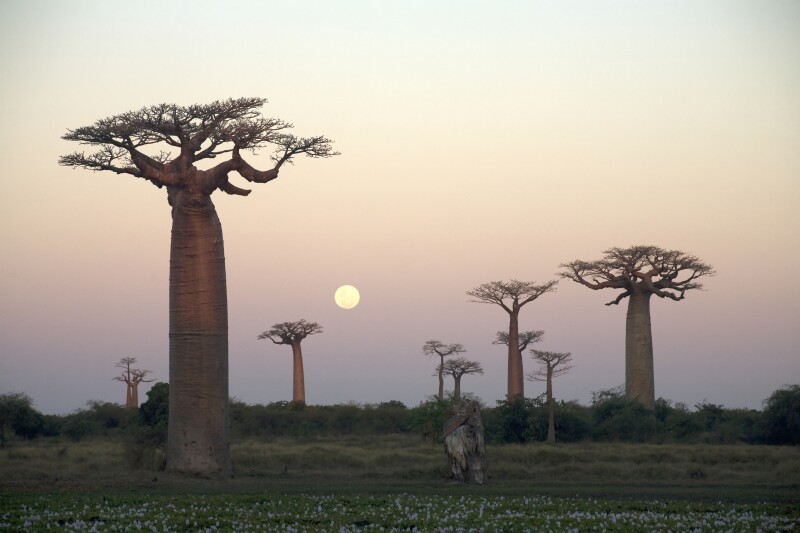It’s not just about faster internet or more devices, but also about a grandmother in a remote village being able to video-call her grandchildren in the city or a young entrepreneur in Lagos, Nigeria, getting the chance to market his products globally.
Africa is a land of huge contrasts. From enormous bustling cities to tiny rural villages, and from massive desert expanses and savannahs to lush, verdant rainforests, a staggering array of settlements and habitats are found there.
There’s also a huge mix of cultures, with Africa containing the world’s 20 most culturally diverse countries. But at the same time, there are big economic contrasts within and between nations. Sub-Saharan Africa, for instance, accounts for more than half the 700-million-strong global population living in extreme poverty on less than US$2.15 per day, according to the World Bank.
In the modern global economy, one of the key ways to alleviate the poverty gap is to improve digital communications infrastructure, given the major benefits this promises in areas from education to financial services and healthcare. Yet there is still a significant digital divide in Africa, with two-thirds of the region’s population remaining unconnected despite the rise in broadband access from 26 to 36 per cent between 2019 and 2022.
Some of the locations where the biggest issues persist are landlocked countries away from coastal subsea landing stations. As a stark example, internet penetration in the Central African Republic stands at only 10% of the country’s 5.5 million people, who often have to also rely on expensive satellite connections for access. In Zambia, meanwhile, penetration is significantly higher at more than 20%, but that still means almost 80% of the population lacks internet access.
At the same time, the increase in access suggests big potential for growth if the infrastructure is there and is combined with an increase in service quality and affordability. It will also be much-needed. For a start, Africa’s already massive population of 1.5 billion is due to expand by a further 1 billion people by 2050.
Secondly, at a median age of just 19, Africa has the world’s youngest population. That puts a huge proportion of people at a time of their lives when they seek not only entertainment, but also a wide variety of educational, financial and commercial services that can support them as they carve out a pathway through their adult lives and careers.

Tree of life
To capture this enormous need and potential for growth, Africa’s own baobab tree can act as an inspiration and template for the way ahead. Often known as the ‘tree of life’ and capable of surviving from hundreds to several thousands of years, the unique, giant and resilient baobab is found in more than 30 countries on the continent and injects life into the ecosystems around it. It provides animals and humans with shelter, food and water, and slows erosion through its extensive root system.
This is an inspiration that pan-African telecoms provider Bayobab is harnessing, having taken its name from the tree in its rebrand from MTN GlobalConnect last May. The refreshed brand reflects the company’s aim to expand across Africa with renewed vigour and in an open-access way. It also forms part of the firm’s Ambition 2025 initiative, which is anchored in building the largest and most valuable platforms in Africa using both fixed and mobile networks across the consumer, enterprise and wholesale segments. The strategy includes aligning Bayobab’s priorities more closely with the development aims of individual markets.
And the company has put major new initiatives into effect to achieve its ambitious future goals. These include big rollouts of terrestrial fibre across markets including landlocked countries, the landing of new subsea routes, and the development of messaging, cloud and API services to meet the latest demands in mobility services. The hope is for people to be empowered in ways that were previously unimaginable, extending Bayobab’s roots to some of the most remote corners of the continent.

Roots of connectivity
To drive the digital economy, enhance GDP and positively impact people’s lives in areas such as education and healthcare, a robust digital infrastructure with underlying connectivity is indispensable.
One of Bayobab’s biggest new projects to meet these essential needs is its entry into a partnership with infrastructure investment platform Africa50 to build a terrestrial fibre-optic cable linking the continent’s eastern and western coasts. Known as Project East2West, the initiative will see up to US$320 million invested in connecting 10 countries in the three years to 2025, expanding Bayobab’s fibre reach from 114,000km today to 135,000km.
While bringing many millions of people online for the first time or providing them with vastly improved internet access, the rollout is also anticipated to slash latency by up to 65% across the route.
The expectation is that this deployment will create a hugely valuable proposition when coupled with Bayobab’s involvement in multiple subsea cables circling the continent, and on which it continues to make major progress.
With investments in 16 such systems around Africa, including the likes of 2Africa, Equiano, EIG, ACE, WACS and EASSy, the company recently announced that it had landed the 2Africa cable in Accra, Ghana, and Lagos, Nigeria. That landing is the fourth in Bayobab’s six planned locations across five countries, including further sites in South Africa and Côte d’Ivoire, creating a cable system to support both Africa’s eastern and western regions.
Meanwhile, the company has shown that its subsea network is resilient and that it is able to respond fast to establish alternatives in the event of disruptions. In March, for example, by collaborating with industry partners, Bayobab swiftly restored operations within days after four cables were cut along Africa’s west coast. In the meantime, it had worked with partners to reduce the impact of the cuts by quickly rerouting traffic and enabling more circuits.
As the company’s activities expand its infrastructure both on land and by sea, the increasing density of its networks will boost both digital access and resilience. They will also help open up digital opportunities in countries including landlocked nations.
Breaking down barriers
Opening up markets in this way is key to solving connectivity problems and helping to foster much-needed social inclusion. Yet deploying infrastructure comes with considerable challenges too, not least the regulatory hurdles and complexities created partly by the wide range of different rules and frameworks in different countries.
Recognising these issues, Bayobab and Africa50 have struck a deal providing support for Project East2West in the area of regulatory and policy engagements with Smart Africa, an alliance of countries, international organisations and private sector players tasked with developing the continent’s digital agenda.
And in general, Bayobab cooperates closely with stakeholders across the value chain in different countries and with regional organisations to facilitate effective cross-border connectivity. This collaborative approach includes explaining the benefits of activities to regulators to spur them into getting behind initiatives.
If those barriers can be successfully broken down while infrastructure simultaneously expands, it will pave the way for innovative players to develop services that promote inclusion. That encompasses companies running both consumer and enterprise services, including smaller operators with all sorts of creative ideas for harnessing wider benefits for the whole of society.
Improving wholesale access for these players is central to the ethos of carrier-neutral, open access that Bayobab sees as an essential part of bridging the digital divide. That ethos extends to the mobile side of the business too, whereby the company serves not only its own 290 million-plus subscribers, but also hundreds of millions more served by other MNOs and digital subscribers on the company’s wholesale network.
Mobile matters

You see a whole lot more people becoming digitally aware and data savvy in Africa, and we see that the young African today needs the ability to be reached through new platforms.
Reliable, effective and compelling mobile services are particularly crucial when taking into account the youth of Africa’s population, creating a big demand for mobile voice, chat and communications via new messaging platforms and roaming ecosystems. When added to the plethora of up-and-coming applications in areas like IoT, the opportunities to support new services are wide and varied.
These services also need to be affordable across a ‘mobile-first’ continent where people may own a single Android phone rather than having a separate MacBook Pro, iPad and iPhone. Their device can serve as a crucial access point to better job and financial aspects, opening up major opportunities for people to get fully immersed in the digital economy.
But this requires careful selection of the right applications to provide a clear pathway to those benefits. If that can be done, it can bring out the type of creativity already seen in the field of mobile banking, in which Africa has led as a hotbed of innovation.
Getting the message across
One area that Bayobab sees as central to boosting the mobility segment is offering the right messaging services, providing improved means for individuals to interact and a launchpad for businesses of all sizes to expand and thrive. Through such avenues, people in emerging markets will be able to catch up by adopting services already used widely in mature markets around the world.
On that front, the company announced in late October that it was set to be Africa’s first telecoms provider to become a WhatsApp Business Solution Provider. Under the deal, Bayobab will act as a third-party provider with expertise on the WhatsApp Business platform, helping to both support parent MTN’s own subscribers, and empower SMEs and digital enterprises to harness the service through conversational messaging. In addition, Bayobab will support businesses in harnessing the benefits of Meta’s WhatsApp Cloud API.
In a similar vein, Bayobab has been developing an API marketplace to aid service providers in delivering more contextual mobile communications and the industry in sharing data.
To help spur that marketplace and in a bid to create Africa’s largest library of open APIs, MTN launched cross-industry platform Chenosis in 2020. This allows developers to tap into a wide range of verticals from a single place, ranging from telecommunications, e-health and e-government to IoT, fintech, e-commerce, payments and location-based services. The platform allows businesses and developers to publish their APIs for other developers to find and use, as well as providing tools that aid API monetisation and promotion.
Used responsibly, harnessing the abundant data that providers have via APIs is a path to creating richer offerings for enterprises and, ultimately, improving the lives of the people they serve.
Limitless possibilities
Meanwhile, looking to the future, the appetite for services like 5G and IoT is set to explode in Africa in the years to come. Although IoT is still in its early stages in the region, the kind of infrastructure needed to support wider-scale rollout is being established in advance through initiatives like Bayobab’s fibre deployment.
The company is also using its extensive connectivity to implement use cases in sectors including logistics, transport, healthcare and education, ensuring that the necessary infrastructure is there ready to cater for the surge.
In addition, Bayobab’s expansion is helping it support the growing appetite for cloud services and edge computing, including aligning with the need to reach people in underserved areas of the continent, move closer to end users and slash latency. Amid these moves, Bayobab has struck up strategic connectivity partnerships with several cloud players, including one in 2023 that supports businesses and public sector organisations in connecting to the Microsoft Cloud.
As the likes of IoT, the cloud and edge computing gain further traction, the accelerating fibre rollout is putting people in a better position to be served across Africa. But it cannot be forgotten that before considering more advanced services, many people in rural areas lack basic reliable connectivity. That is, first and foremost, what the type of deployment being undertaken by Bayobab will achieve, giving people the platform to then benefit from all the opportunities brought by the latest cutting-edge services.
In building these continent-wide fibre ‘railways’, there is a need to always remain conscious of the nuances and distinguishing features between countries – thus helping navigate the continent’s complex terrain in the most efficient way possible and provide appropriately targeted services in each country.
Keeping that firmly in mind will help establish the right services to support the digital requirements of everyone, all the way from a grandmother in a remote rural village to a young entrepreneur looking to make their first big steps in the business world.





